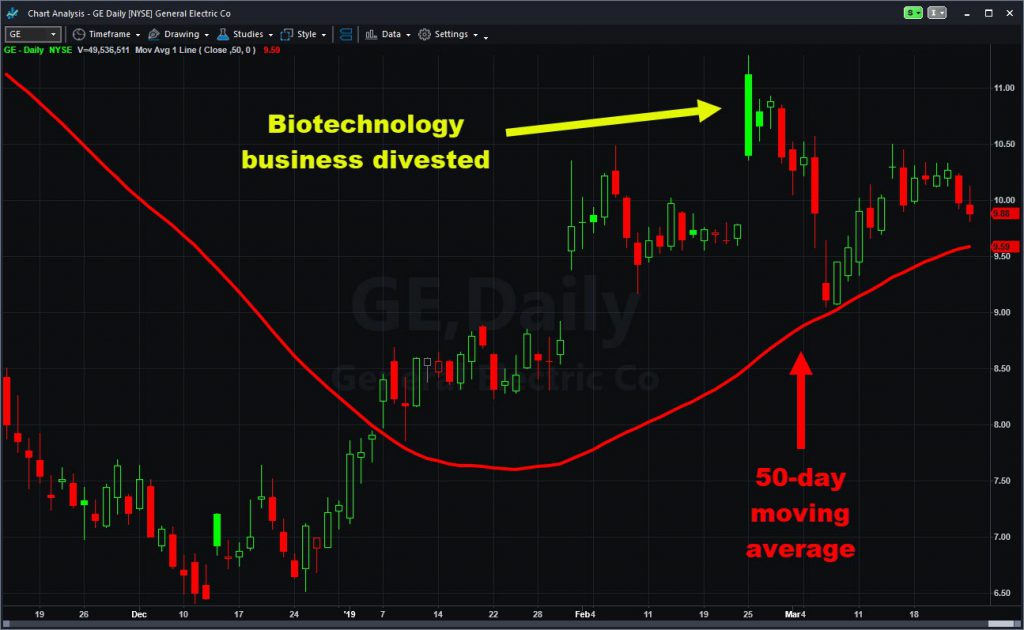This is the final post in a seven-part series on the catalysts for stock movements. It’s based on a series of talks at TradeStation’s Master Class learning sessions.
Companies are not just businesses. They’re also corporate entities with financial structures that can be changed to impact stock price. Events like this fit under the category of strategic actions.
This is the seventh and last major catalyst of movement in the equity market. We’ll define it as management altering a firm’s corporate or capital structure — usually via divestiture, spinoff, buyback or acquisition.
Strategic actions have nothing to do with a company’s core business. That makes them different from business transformation, which is when management looks to improve products or operations.
Divestitures
Let’s start with divestitures because they’ve been in news recently. For example, General Electric (GE) rallied a month ago after selling its biotechnology division. And yesterday, Ascena Retail (ASNA) ripped on news it would unload the Maurices chain.
Divestitures consist of selling a business unit. This can benefit a company by raising money better used elsewhere. Sometimes it helps pay off debt. (That involves credit, another of the seven catalysts.) At other times, funds from a divestiture can go to buying back shares or a special dividend. (More on those below.)

Second, shedding subsidiaries can let executives focus attention on their core business. That can improve profitability and sales.
Third, investors often demand higher multiples for “pure play” companies. To understand this, take a hypothetical example from grocery shopping. Imagine that a store forced you to buy rice and salsa together in a single package.
The bag of rice and jar of salsa may both have a $2 price. But forcing the shopper to purchase them together will reduce demand for both. An actively quoted market like Wall Street would instantly discount the combination below $4.
Money managers think about companies the same way. They want exposure to categories like “memory chips,” “footwear” or “oncology.” Each of those have their own price or valuation metrics. Forcing them all under the same roof muddies the water in the eyes of money managers.
Spinoffs
That brings us to the second major kind of strategic actions, spinoffs. This is when a company splits off a business and gives it to existing shareholders as a new stock.
A recent example of this was Gap (GPS) deciding to separate its flagship brand from Old Navy. Eli Lilly (LLY) also finished spinning off Elanco Animal Health (ELAN) this month.
A spinoff is similar to a divestiture because it helps sharpen a company’s focus. In that respect it can also solve the rice-and-salsa problem mentioned above, and encourage investors to pay more for the stand-alone company.
Spinoffs differ from divestitures because they directly change the stock structure and don’t involve cash. They also have certain tax benefits.
Buybacks, Dividends and Mergers
Buybacks and dividends fall under strategic actions because they impact capital structure. Management can take spare cash, or even borrow money, and give it to shareholders.
They can buy back their own equity on the open market, reducing the share count. (Less stock in supply can mean higher prices.) Or, they can pay quarterly dividends. Alternately, a company may announce a one-time special dividend.
Finally, the biggest kind of strategic action is selling a company. This can take several forms: hiring investment banks, seeking “strategic alternatives” or breaking-news reports citing anonymous sources.
How to Trade It
You need to know about strategic actions because they can overshadow all other aspects of a stock’s performance. For example, say a company is spinning off a business that accounts for half its revenue. Such a huge change will produce a very different company when the transaction is finished.
That can make investors ignore other events that would normally matter, like quarterly results. Instead, the market will completely focus on timing and terms of the upcoming strategic event.
Alternately, people might be expecting a merger to occur (or not occur). It could be hung up on negotiations or regulatory approvals. Again, incremental news around the outcome will dominate price action.
This is important because we’re looking to understand why stocks move. Fundamentals like earnings typically matter. But sometimes strategic events matter even more.
Putting it All Together
Hopefully you’re starting to see how these seven key catalysts can fit together. A company may divest a business line (strategic action) and use the cash to pay down debt (credit event). The new company can then focus on lifting volumes or margins.
Or, a company may want to reinvent itself to keep up with the times. Consider an example like Corning (GLW). In the 1990s the glass maker divested its cookware operations and transformed itself into a fiber-optic maker. In the process it was responding to investor rotation into technology stocks during the dotcom boom.
In conclusion, there are limitless ways these seven catalysts may fit together to explain stock movement. Hopefully this series has allowed you to understand the basics so you can quickly identify the forces at work in the market.





















